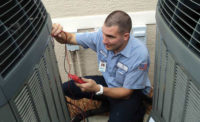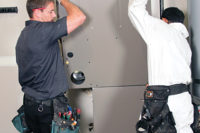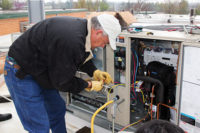[Editor’s note: This is the first in a two-part series of articles summarizing the State of HVAC survey Emerson conducted and is sharing exclusively with The NEWS. The survey was sent out in February and was a follow-up to the first survey, which was sent in September 2013.]
While the HVAC regional standards issue has finally been resolved by industry stakeholders and the courts, the focus is now shifting to how prepared the industry is for this change.
The court-approved settlement agreement vacates the contentious regional furnace efficiency standards and restarts the rulemaking process, this time giving stakeholders a greater opportunity to provide input throughout the rulemaking process. The settlement also gives the industry an 18-month sell-through period to comply with the Jan. 1, 2015, efficiency standards for split system air conditioners in order to help avoid stranded inventory. Additionally, as part of the agreement, the U.S. Department of Energy (DOE) has agreed not to penalize distributors as part of the standard’s enforcement.
Although this survey was conducted before the court accepted the settlement, the findings are still very informative.
When comparing the September 2013 and February 2014 survey results, the needle did not move substantially in regards to awareness and impact. In September, 74 percent of respondents said they were either unaware or unsure of the impact of the regional standards while in February, 66 percent were unaware or unsure of the impact.
“Generally, we expect awareness to increase. This is going a little slower than the 2006 change to 13 SEER,” said Frank Landwehr, vice president of marketing and product planning for Emerson Climate Technologies’ air conditioning business. “This appears to be a little bit under their radar. I was surprised by the initial results in September, but I am starting to understand them. Obviously, the efficiency and technology changes are not quite as big as they were back in 2005 for contractors. That was a 30 percent increase in efficiency and a big change in the size of the equipment.”
Frank was quick to point out the regulation changes might be more impactful to distribution, and questions regarding enforcement could become an issue.
“We will wait and see on the enforcement. If the burden of enforcement and possible audits and penalties falls on contractors, it will probably move up to the top of their list of concerns,” Landwehr said.
When asked what have they done to prepare for the regional standards, 37 percent of responding contractors said nothing, which was a big improvement over the previous survey, when 50 percent said they had done nothing.
When asked to describe the impact the standards would have on their businesses, it was a mixture of positive and negative. A total of 38 percent said there would be an upsell opportunity with higher revenues and margins, while 26 percent were concerned about their ability to compete and remain in business.
“I think the contractors in the West are worried about room window air conditioners,” said Joe Linsenmeyer, director of residential marketing, Emerson Climate Technologies. “When we had the 13 SEER change, there was a big spike in window units because people didn’t want to pay for the new unit. It gets overcome, after a time, but the higher you pump up the efficiency, the more of that type of resistance you might have.”
The ramifications of this change could largely depend on where you are running your business. HVAC businesses operating in the Northern region will be impacted the least, a slightly bigger change is expected in the Southeast, and HVAC businesses located in the Southwest may see a significant change.
The upsell opportunities might also differ according to region. Overall, 67 percent of respondents expect their sales of equipment rated 16 SEER and above to increase after the standards go into effect.
“It seems to depend on where you are. In the Southeast, contractors might be able to upsell based on comfort and energy savings,” Linsenmeyer said. “In the more arid regions of the Southwest, their upsell opportunities based on comfort are limited, but there might be other factors that emerge. In the North, where only the heat pump efficiency is changing, there might be some opportunity to upsell based upon improved heating efficiency and comfort from premium heat pump and dual-fuel systems.”
In the past, when new regulations have gone up, what happens is the mid-tier becomes the base, the premium becomes the mid-tier, and there is a new top-level premium. The base grows a lot, the mid-tier shrinks, and the premium essentially becomes microscopic. As time passes, the mid-tier and the premium eventually grow.
The latest standards should not be a curveball to the contractor because most contractors have already installed equipment that would meet the new minimum standards.
“In 2006, the high-efficiency equipment got squeezed,” Landwehr said. “The theme for us is that we think a lot of contractors can upsell over time. We believe in helping them do that because it would be good for the industry. Showing them how to do that is important. Our theory is, once you are talking about technical items, such as efficiency and SEER rating, you might as well go all the way. You have introduced the concept because of regulations, so, you might as well give them the choice instead of just giving them the lowest cost.”
When asked what benefits/services they will use to upsell the customer, 75 percent said higher efficiency and payback, 58 percent said increased comfort (modulation and humidity control), and 55 percent said quieter operation.
Publication date: 6/2/2014
Want more HVAC industry news and information? Join The NEWS on Facebook, Twitter, and LinkedIn today!







Report Abusive Comment